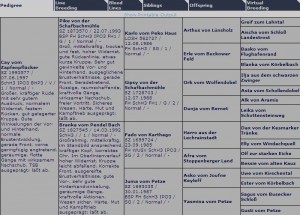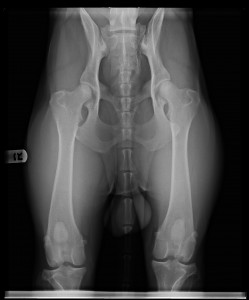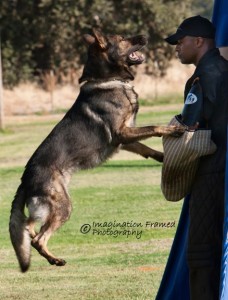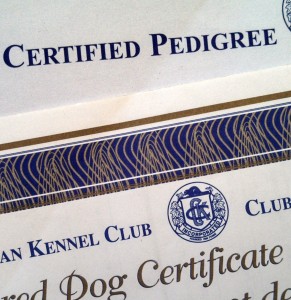Red Flags: Backyard Breeders
 With an increasing number of breeders turning to the Internet to create more of a presence for themselves and their dogs, it is important for potential puppy buyers to know how to sift through their websites to determine a good breeder from a mediocre breeder. This blog looks specifically at red flags that indicate a poor quality “backyard breeder”. A “backyard breeder” generally is anyone who breeds their purebred dog without any regard for health, temperament, genetic screening, or proof that the dog is actually breedworthy. If you are looking for a healthy German Shepherd puppy with a stable temperament and good genetics, then you want to stay away from these types of breeders!
With an increasing number of breeders turning to the Internet to create more of a presence for themselves and their dogs, it is important for potential puppy buyers to know how to sift through their websites to determine a good breeder from a mediocre breeder. This blog looks specifically at red flags that indicate a poor quality “backyard breeder”. A “backyard breeder” generally is anyone who breeds their purebred dog without any regard for health, temperament, genetic screening, or proof that the dog is actually breedworthy. If you are looking for a healthy German Shepherd puppy with a stable temperament and good genetics, then you want to stay away from these types of breeders!
Red Flags that Indicate “Backyard Breeder”
1. “Shepherd” is misspelled.
Every good breeder knows how to spell the name of their beloved breed. If the website says “Sheppard”, “Shepard”, “Shephard” or any other various misspelling of “German Shepherd”, move on.
2. Dogs are listed only by call name, with no links to pedigrees or full registered names.
Full registered names are searchable, and can be used to verify health, titles, and pedigrees. Coincidentally, full registered names are rarely listed on the websites of backyard breeders, leaving the potential buyer unable to research the breeder’s breeding dogs to verify the pedigrees and health information.
Good breeders are proud of their dogs, and will always list or provide the full registered names. They have nothing to hide, and want potential puppy buyers to know what other dogs, accomplishments, and bloodlines are behind their dogs. If all you see are call names no matter where you go on the site, move on, especially if they are not linked to the dog’s full pedigree that contains their registered name.
3. No pedigrees are available anywhere on the site, and cannot be found in any online database.
 Pedigrees are so much more than “papers”. A pedigree is a valuable tool for helping evaluate and trace specific bloodlines, traits, temperament, and working ability through generations. Good breeders know how to read and use a pedigree, and know the genetic strengths and weaknesses of their dogs and of the dogs behind them in the pedigree. They typically post the pedigrees online using one of the several online databases for German Shepherds such as Pedigree Database, Working Dog.EU, or WinSis-CAT online (please note: anyone can edit Pedigree Database and Working-Dog.eu, so always double-check the information!), or will provide a copy upon request. This pedigree on the left is of the sire of John’s dog Bruno vom Midlicher Land IPO3, and is from WinSis-CAT online, which uses trial results to verify pedigree information. Breed surveys, titles, hip and elbow ratings, and more are also recorded on the pedigree.
Pedigrees are so much more than “papers”. A pedigree is a valuable tool for helping evaluate and trace specific bloodlines, traits, temperament, and working ability through generations. Good breeders know how to read and use a pedigree, and know the genetic strengths and weaknesses of their dogs and of the dogs behind them in the pedigree. They typically post the pedigrees online using one of the several online databases for German Shepherds such as Pedigree Database, Working Dog.EU, or WinSis-CAT online (please note: anyone can edit Pedigree Database and Working-Dog.eu, so always double-check the information!), or will provide a copy upon request. This pedigree on the left is of the sire of John’s dog Bruno vom Midlicher Land IPO3, and is from WinSis-CAT online, which uses trial results to verify pedigree information. Breed surveys, titles, hip and elbow ratings, and more are also recorded on the pedigree.
Backyard breeders, on the other hand, usually just view pedigrees as proof that the dog is purebred. They do not know how to evaluate the strength or quality of the pedigree, nor how to use it to trace the genetics behind their dogs. They typically know little about the genetic history behind their dogs, other than that all the parents and grandparents were “AKC-registered” or “papered”. They will not be able to explain the genetic strengths, weaknesses, temperament, and potential health issues behind their dogs, because they do not know this information. If they provide the pedigree upon request, it typically is full of several generations of untitled, untested dogs.
If this is the case, then move on and look for a more knowledgeable breeder who truly understands the genetic history of their particular dogs, and who uses dogs of better quality in their breeding program.
4. The breeder’s main claims are that the dogs are AKC-registered, or that their dogs come from “Champion Bloodlines”.
We have discussed this myth of AKC registration being an indication of quality in a previous blog. But another commonly tossed around phrase is that of “champion bloodlines”. You may hear explanations like: “Well, she comes from champion bloodlines from Germany”, or “There’s lots of Schutzhund titles behind him, and his great-grandfather competed in the WUSV”. But then an analysis of the pedigree reveals several recent generations of untitled, untested, backyard bred dogs before you eventually find good dogs who had been proven before breeding. Thus, their “champion bloodlines” and Schutzhund-titled dogs may be four, five, or even six generations back in the pedigree, where they now exert little influence on the current generation of dogs.
Because all dogs in Germany must have a breed survey, show rating, and at least a SchH1 title before being bred, any dog that has ancestors from Germany will therefore have titles somewhere in the pedigree. Since the GSD breed arrived here in America after World War I, with increases in imported dogs seen again after World War II, all GSDs here in America will eventually have titled dogs from Germany generations back in their pedigrees. However, this does not mean that this current dog in the breeder’s backyard is therefore of breeding quality!
More important than what distant ancestors have accomplished is what the dogs most recent in the pedigree have accomplished. Have THEY proven themselves breedworthy, and if so, how? Have they actually DONE something besides sit in the backyard and make puppies? Were they titled, and the parents titled? Or is it just several generations of untitled backyard-bred dogs, who eventually have titled European dogs several generations back? If this is the case, move on. Look for a breeder who has proven their dogs to be breedworthy BEFORE they were bred, and who does not just rely on the accomplishments of distant ancestors to “sell” their puppies.
5. No health certifications are listed, and cannot be proven by the breeder.
 Hip and elbow certifications should be listed at a minimum, and many breeders are choosing to test for DM (Degenerative Myelopathy) as well. If done through the Orthopedic Foundation For Animals (OFA), the record of the hip, elbow, and DM ratings may also be found in the online database at www.offa.org. Some breeders send their hip and elbow x-rays into Germany to be certified through the SV. Either way, proof of valid hip and elbow certifications should be provided.
Hip and elbow certifications should be listed at a minimum, and many breeders are choosing to test for DM (Degenerative Myelopathy) as well. If done through the Orthopedic Foundation For Animals (OFA), the record of the hip, elbow, and DM ratings may also be found in the online database at www.offa.org. Some breeders send their hip and elbow x-rays into Germany to be certified through the SV. Either way, proof of valid hip and elbow certifications should be provided.
These basic health tests for the GSD breed ensure that the breeding dogs are free from potentially painful and crippling genetic disease, and therefore have a much lower risk of passing this on to puppies. Hip and elbow dysplasia can only be diagnosed conclusively through radiographs (x-rays). Excuses like “my vet said they looked great”, “the dog comes from a long line of good hips”, “they’ve never shown any signs of hip problems” do not cut it! The physical symptoms of these diseases are vague, chronic, and often mimic other conditions. Thus, x-rays must be taken, and must be read by expert radiologists to truly show what is happening in the hip and elbow joints.
Never take a breeder’s word for it; ask for proof, and if it is not provided, move on. Find a better breeder who truly cares about the health of the dogs they use, and of the puppies they produce.
6. No working titles of any kind are listed, or there are invented titles after the dog’s name.
Good breeders train and work their dogs in a meaningful venue besides basic obedience. Backyard breeders typically just breed their dogs and do little else with them besides having them produce puppies and live in their house as a pet (or live in the backyard). However, the German Shepherd Dog is a working dog first and foremost, not just a “pet dog”! Work and temperament have been linked from the very beginning of the breed; each one needs the other in order to maintain the German Shepherd breed.
Invented titles include “titles” like “Personal Protection Level 1”, “Executive Protection Dog Level 2”. These are not actual certifications or titles that are awarded by any legitimate organization. Personal protection is something the dog does; it is not something the dog earns based on a performance against a standardized set of rules in front of an objective judge, who is continually evaluating the genetic temperament and working ability of the dog. The breeder of the dog pays to have personal protection training put on their dogs, and then declares it as a “title” without ever having the dog evaluated by an objective outside party. Thus, personal protection “titles” do not sufficiently test the temperament of the dog, and are not evidence of breedworthiness!
Certificates like Canine Good Citizen (CGC), Temperament Tested (TT), Herding Instinct Certified (HIC) are not working titles. These are basic certifications that do little to test the actual genetic working temperament and abilities of the dog. Look for IPO titles, advanced obedience titles, advanced agility titles, advanced herding titles, legitimate Search and Rescue, Explosives Detection, or Patrol Dog certifications. These titles should be verified as well; many results are searchable, and the dog’s name should show up in trial results. Titles in protection sports like IPO are especially important for working breeds like the GSD.
We have written about the importance of working titles on dogs in the past. While titles are not “everything” (as many are fond of pointing out), legitimate titles show that the dogs are capable of being trained and worked, have had their temperament tested in a venue outside of their own backyard, and show that the breeder does more with their dogs than just breed. If the dogs are being bred without having their temperament and working ability proven, move on and find a better breeder.
7. There are no photos or video of the dog working or performing any meaningful activity.
 Good breeders post working photos and videos of their dogs. They are proud of the accomplishments of their dogs, of their working ability and character and temperament. Mediocre or backyard breeders have nothing to brag about, because they do very little with their dogs except breed them; they simply avoid or hide this issue altogether by posting only a few glamour shots of their dogs: head shots, the dog standing in a stack, or of the dog laying down in the backyard or playing ball.
Good breeders post working photos and videos of their dogs. They are proud of the accomplishments of their dogs, of their working ability and character and temperament. Mediocre or backyard breeders have nothing to brag about, because they do very little with their dogs except breed them; they simply avoid or hide this issue altogether by posting only a few glamour shots of their dogs: head shots, the dog standing in a stack, or of the dog laying down in the backyard or playing ball.
If there is no proof of the dog being anything other than a pet or lawn ornament, move on! Keep an eye out for pictures stolen from other breeder websites, as well.
8. Dogs are purposely bred out of standard.
This includes the breeder whose dogs are advertised as being “huge”, “oversize”, “Old World”, or a “rare color” like white, liver, and blue. The breeder should KNOW what the GSD is, and the GSD is none of the above! This “breeder” shows that they do not know nor care to adhere to the standard that makes the GSD what it is. Why, then, are they breeding and selling “German Shepherd puppies” if they show a complete disregard for what the breed is supposed to be?
While there are plenty of puppy buyers out there who think it is “cool” to own a ‘rare shepherd’, they really are buying backyard-bred dogs of inferior quality that have been bred for only one aspect: appearance. Health and temperament are rarely PROVEN before breeding, and both health and temperament problems abound in these “special” GSDs. The pedigrees typically contain generation after generation of untitled, untested dogs that were bred simply because they exist as intact animals.
The breed standard exists for a reason, to ensure that the German Shepherd Dog remains a German Shepherd Dog. German Schutzhund Judge Dietmar Schellenberg poignantly sums up the situation:
“To meet an ever-growing demand, some breeders betray the characteristic temperament traits of working dogs…many of today’s behavior problems are the direct result of this irresponsible breed manipulation.” (Top Working Dogs)
9. Dogs are bred before two years of age.
Backyard breeders often have little knowledge of canine reproduction and of the proper breeding recommendations for the breed. For German Shepherd Dogs, the minimum breeding age is two years old. This was instituted for several reasons:
- To allow the dog to fully mature both physically and mentally
- To reduce the risk of breeding complications, and of pregnancy and whelping complications
- To allow time for the dog to be appropriately trained, titled, and proven before breeding
- To allow time for genetic screenings like hip and elbow x-rays to take place. OFA certification, for example, requires that the dog be a minimum of two years of age.
- To allow time for the breeder to uncover the genetic strengths and weaknesses of their dogs, so as to make informed breeding decisions
If the “breeder” is breeding females before they are two years old, or has stud dogs who are only one year old, run the other way! This breeder shows a complete disregard for the health and well-being of their breeding dogs, not to mention a complete lack of knowledge of canine reproduction. Why support a “breeder” who knows so little about breeding, and who apparently cannot be trusted with properly caring for their breeding dogs (let alone puppies)?
These are just a few of the most obvious and glaring red flags that indicate a mediocre or backyard breeder. If you choose to buy a puppy from a breeder like this, you do so at great risk and often at great long-term cost, once health and temperament issues surface in the dog. You might get lucky and get a great dog that is healthy and happy, or you might be one of the thousands of owners posting on the various German Shepherd message boards and online forums, asking for help with all the health and temperament problems of their backyard-bred German Shepherd puppy they got “for a great price”.
Next blog we will discuss the red flags on breeder websites that indicate a large-scale “commercial” breeder who breeds to make money off producing lots of puppies, instead of breeding for good German Shepherd Dogs.


